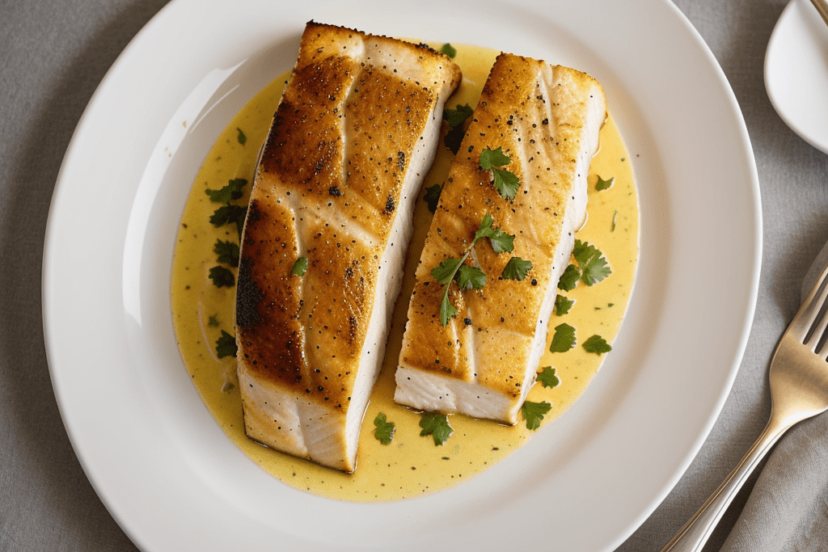Mahi Mahi Nutrition: The Fitness Enthusiast’s Guide
*We may earn a commission for purchases made using our links. Please see our disclosure to learn more.
Mahi Mahi Nutrition: Key Health Benefits and Nutritional Profile
So what does the Mahi Mahi Nutrition profile look like? That is the topic of discussion today so let’s jump in! Mahi Mahi, also known as Dorado or dolphinfish, is not only a sought-after game fish but also a delightful seafood choice known for its firm texture and mild flavor. As a holistic nutritionist, I often recommend this fish to individuals looking for a nutritious addition to their meals. One of the most compelling reasons to incorporate Mahi Mahi into a diet is its impressive nutritional profile. It is a lean source of high-quality protein, essential for building and repairing tissues, and it also plays a crucial role in maintaining a healthy immune system.

The nutritional benefits of Mahi Mahi extend beyond its protein content. I appreciate that it serves as a good source of vitamins and minerals such as B vitamins, which help convert food into energy, and minerals like selenium, important for antioxidant defense and thyroid function. It’s also notable for its content of omega-3 fatty acids, although not as high as in fatty fish like salmon or mackerel, omega-3s are vital for heart health and may reduce inflammation throughout the body.
Furthermore, for those managing their dietary intake, the calorie count of Mahi Mahi is relatively low, making it an excellent choice for weight management. Regularly including Mahi Mahi in a balanced diet offers a tasty and versatile way to help meet nutritional needs without compromising on flavor. Whether grilled, baked, or sautéed, this fish can be a delightful centerpiece in a health-conscious meal plan.
Mahi Mahi Nutritional Profile

Mahi mahi, also known as dolphinfish, is a nutritious seafood choice cherished for its firm texture and mildly sweet taste. I’ll explore its nutritional content, focusing on its macro-nutrient breakdown and the array of vitamins and minerals it contains.
Macro-Nutrient Breakdown of Mahi Mahi Nutrition
- Calories: A 100g serving of mahi mahi typically contains about 85 calories, making it a low-calorie source of high-quality protein.
- Protein: With around 18.5 grams of protein per 100g, mahi mahi is an excellent source for maintaining muscle mass and supporting cellular repair.
- Total Fat: Mahi mahi is lean, featuring just 1 gram of fat per 100g serving. The fat content includes:
- Saturated Fat: Minimal amounts are found in mahi mahi.
- Trans Fat: Not present.
- Polyunsaturated Fat: Includes omega-3 fatty acids, albeit in lower quantities than fatty fish like salmon.
- Monounsaturated Fat: Present in small quantities.
- Total Carbohydrate: Mahi mahi contains no carbohydrates, making it suitable for low-carb diets.
- Dietary Fiber: None present.
- Sugars: Mahi mahi is free of sugars.
Vitamins and Minerals Content
- Vitamin B12: One serving of mahi mahi is a rich source of vitamin B12, crucial for nerve function and the formation of DNA and red blood cells.
- Selenium: This essential mineral is abundant in mahi mahi and supports antioxidant activity and thyroid function.
- Potassium: An important mineral for heart health, potassium is found in good quantities in mahi mahi.
- Phosphorus: Contributes to the formation of bones and teeth and is found in mahi mahi.
- Magnesium: Present in mahi mahi, it aids in many biochemical reactions in the body.
- Niacin (Vitamin B3): This nutrient in mahi mahi helps convert food into energy.
- Additional Vitamins and Minerals: Mahi mahi contains other vitamins such as vitamin B6 and traces of minerals like zinc, but not significant amounts of vitamin A, vitamin C, vitamin D, calcium, iron, dietary fiber, or sugars.
The Recommended Daily Intake (RDI) for these nutrients varies based on an individual’s age, sex, and level of physical activity. Mahi mahi’s nutrient profile contributes positively to a healthy diet and can be a part of a balanced meal plan, especially for those seeking a source of protein and essential nutrients with low caloric content.
Health Benefits of Mahi Mahi

Mahi Mahi, a fish known for its firm texture and sweet flavor, is not only a delightful culinary choice but also a powerhouse of nutrition. Offering a variety of health benefits, Mahi Mahi is an excellent source of high-quality protein, essential vitamins, and minerals.
Cardiovascular Health
Mahi Mahi is rich in omega-3 fatty acids, which are key in managing heart health. Omega-3s help reduce inflammation and can lower the risk of chronic diseases such as heart disease. They also contribute to the maintenance of healthy blood pressure and cholesterol levels, supporting overall cardiovascular health.
Weight Management
For those managing their weight, Mahi Mahi is a lean source of protein that can be a helpful addition to a balanced diet. Its high protein content can increase feelings of fullness, which may prevent overeating. Additionally, Mahi Mahi is low in calories, making it a suitable choice for calorie-controlled diets.
Muscle and Tissue Development
The high-quality protein found in Mahi Mahi is essential for muscle growth and repair. Protein is a key nutrient for maintaining muscle mass, especially important for athletes or those engaged in regular physical activity. The protein in Mahi Mahi helps ensure proper development and recovery of muscles and tissues.
Cognitive and Nervous System Health
Mahi Mahi provides valuable B vitamins, including vitamin B3 (niacin), B6, and B12, which are crucial for cognitive function and the health of the nervous system. These vitamins aid in the maintenance of nerve function, can support brain health, and may even positively affect mood. The presence of selenium, an antioxidant, further enhances immune function and combats oxidative stress, contributing to neurological health.
Comparative Analysis With Other Fish

When comparing the nutritional attributes of mahi mahi to other popular fish like tilapia and salmon, I consider factors such as omega-3 content, calorie count, and their position on the mercury index to provide a comprehensive nutritional comparison.
Mahi Mahi vs. Tilapia
Mahi Mahi: Commonly known as dolphinfish, it offers a robust profile of B vitamins, specifically niacin (B3), vitamin B6, and vitamin B12, which are essential for energy metabolism and nervous system health. It is lean and low in calories.
Tilapia: A widely-consumed white fish, tilapia is praised for its low-fat content and has a milder taste compared to mahi mahi. However, mahi mahi surpasses tilapia in omega-3 fatty acids, which are beneficial for heart and brain health.
| Nutrient | Mahi Mahi | Tilapia |
| Calories | Low | Low |
| Fat Content | Low | Very Low |
| Omega-3 Fatty Acids | Moderate | Lower |
| Vitamin B12 | Significant | Moderate |
| Mercury Content | Low to Moderate | Low |
Mahi Mahi vs. Salmon
Mahi Mahi: With fewer calories and less fat than salmon, mahi mahi remains a rich source of protein and essential nutrients, making it an excellent choice for a healthy diet.
Salmon: Salmon is renowned for its higher omega-3 fatty acid content, which supports skin, hair, heart, and brain health. These nutritional benefits position salmon as a superior option for those specifically seeking a boost in omega-3 intake.
| Nutrient | Mahi Mahi | Salmon |
| Calories | Lower | Higher |
| Fat Content | Lower | Higher |
| Omega-3 Fatty Acids | Moderate | High |
| Vitamin B12 | Significant | Significant |
| Mercury Content | Low to Moderate | Moderate |
Low Mercury Content Fish and Mahi Mahi Nutrition
In terms of mercury content, it’s important to select fish that are low on the mercury scale for frequent consumption. Mahi mahi is considered to have low to moderate mercury levels, making it a safer option over fish prone to high mercury accumulation like swordfish.
Low Mercury Fish include tilapia and salmon, aside from mahi mahi, and can be eaten more regularly without the concern of mercury exposure to the same extent as some larger predatory fish. It’s important to consider these factors when incorporating fish into a balanced diet.
Preparation and Cooking Tips

Before diving into seasoning and cooking techniques, I want to stress the importance of handling Mahi Mahi correctly. Ensuring the fish is properly seasoned and using healthy cooking methods will not only enhance the flavor but also retain its nutritious value.
Proper Seasoning Methods
When preparing Mahi Mahi, the seasoning can make a world of difference. I always start by patting the fillets dry with paper towels to remove excess moisture. This step is crucial for the seasoning to adhere properly. For a simple yet effective marinade, I mix together:
- 1/4 cup of fresh lemon juice
- 2 tablespoons of olive oil
- 1 tablespoon of honey
- A pinch of salt
I ensure the mix is well combined before placing the fish in a zip-lock bag and pouring the marinade over it. It’s important to let it sit in the refrigerator for at least 45 minutes. When it comes to spices, I prefer a light touch, using complementary flavors like:
- Garlic powder
- Paprika
- Black pepper
I sprinkle them evenly over the fish to enhance its natural flavors without overpowering it.
Healthy Cooking Techniques
For a healthy method, baking Mahi Mahi is my go-to. It’s simple and preserves the fish’s delicate texture. I preheat my oven to 375 degrees Fahrenheit and lightly brush a baking dish with olive oil to prevent the fish from sticking. I then arrange the marinated fillets on the dish and bake for approximately 15 to 20 minutes. The fish should reach an internal temperature of 145 degrees Fahrenheit — a sign that it’s cooked to perfection.
Grilling is another excellent technique for a lean, high-protein dish. I make sure my grill grates are clean and well-coated with oil to avoid any sticking. Grilled fish, especially Mahi Mahi, should be cooked over medium-high heat for about 4 to 5 minutes on each side, or until the internal temperature is correct and the flesh is opaque throughout.
Whether I choose to bake or grill, I avoid breading as it adds unnecessary carbs and fats. Instead, I might serve the fish with a side of vegetables to keep the meal balanced and nutritious. Remember, the goal is to let the natural taste of Mahi Mahi shine through while maintaining a healthy profile.
Selecting and Storing Mahi Mahi

When purchasing mahi mahi, commonly known as dorado, my focus is on the fish’s quality and freshness—both of which have a significant impact on its mild flavor and firm texture. Proper storage is essential to maintain these attributes and ensure the fish stays low in calories and high in nutrients.
Choosing the Right Mahi Mahi
I always look for mahi mahi that appears fresh and displays a bright color; dullness can be an indicator of age. The size of the fish can influence the texture, with larger ones typically being firmer. Mahi mahi should have a clean smell, and the flesh should spring back when touched. When available, I consult a food database or calorie counter to check the nutritional aspects such as daily values of fiber and sugar.
Storage Guide for Mahi Mahi Nutrition
Refrigeration: If I’m planning to consume mahi mahi within one to two days, I store it in the refrigerator at the coldest part, typically the bottom shelf. Here’s how I ensure maximum freshness:
- Wrap the fish tightly in plastic wrap or place it in an airtight container to prevent air and moisture exposure.
- Ensure the fish is cooled completely before refrigeration to avoid contamination or spoilage.
For extended storage, I recommend freezing the mahi mahi. I use these methods:
- Wrap the fish tightly in foil, plastic wrap, or a vacuum-sealed bag.
- Place the wrapped fish in the freezer where it can be kept for up to two to three months.
When I’m ready to use the mahi mahi, I defrost it by transferring it to the refrigerator for 24 hours or using cold water if I’m short on time. Remember to never refreeze previously thawed fish to prevent a loss in quality and potential food safety issues.
Frequently Asked Questions about Mahi Mahi Nutrition
In this section, I’ll address some common inquiries regarding the nutritional aspects of Mahi Mahi, revealing how it stacks up against other protein sources and the health benefits it offers.
1. How does the protein content in Mahi Mahi compare to other fish?
Mahi Mahi is a good protein source, typically offering about the same amount of protein as other popular fish varieties. For example, a 3-ounce serving provides about 20 grams of protein, comparable to fishes like cod or haddock.
2. What are the health benefits of consuming Mahi Mahi?
Mahi Mahi is rich in vitamin B complex, specifically niacin (vitamin B3), vitamin B6, and vitamin B12, which are important for energy metabolism and maintaining a healthy nervous system. Moreover, it provides a good source of omega-3 fatty acids known for supporting heart health.
3. How many calories are in a serving of Mahi Mahi?
A 3-ounce serving of Mahi Mahi typically contains approximately 90 to 100 calories, making it a lean choice for those monitoring their calorie intake.
4. What is the Omega-3 fatty acid content in Mahi Mahi?
While Mahi Mahi is not the highest source of Omega-3 fatty acids compared to fish like salmon, it still offers a beneficial amount. The Omega-3 content can contribute to heart and brain health, though specific levels can vary based on factors like the fish’s diet and environment.
5. How does the nutritional profile of Mahi Mahi compare to chicken?
When comparing Mahi Mahi to chicken, both are excellent sources of lean protein. However, Mahi Mahi offers unique advantages such as higher levels of certain B vitamins and omega-3 fatty acids, which are less prevalent in chicken.




